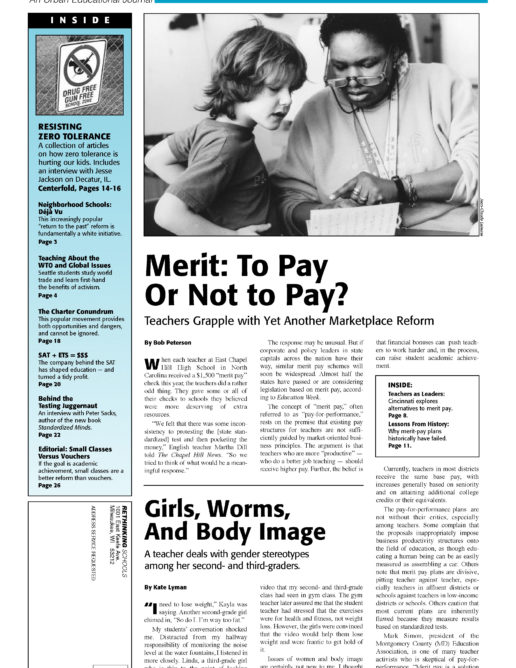Small Classes Versus Vouchers
Rethinking Schools Editorial
No one really knows how the children receiving vouchers are performing academically.
Smaller classes have led to improved achievement, particularly for African-American students.
The results – or lack of – in the voucher program are particularly noteworthy.
In recent years, there has been an ongoing controversy over academic achievement in the Milwaukee voucher program. The controversy has rested on an interpretation of data from the program’s early years, when it was serving several hundred students in a handful of schools. Quite frankly, the controversy had become a tempest in a teapot.
When religious schools were allowed to take part in the voucher program, beginning with the 1998-99 school year, the program mushroomed. This school year, approximately 8,000 students in 91 private schools in Milwaukee are receiving vouchers. Most students are at religious schools.
But as a recent Legislative Audit Bureau report makes clear, no one has any clue if the students are performing better, worse, or about the same as their counterparts in the Milwaukee Public Schools (see article on the LAB report.).
When the religious schools were included in the program, the legislature dropped attempts to gauge the academic achievement of participating students because the religious schools worried about government interference in religion. As a result, the private voucher schools are not currently required to give any standardized tests. Even if they do give tests, they are not required to release the results.
Available evidence suggests that there are some good private schools, some mediocre private schools, and some lousy private schools. (Three voucher schools this year are so bad that even the privately funded PAVE program will not provide scholarships to the schools.) Merely giving money to private schools is not the educational magic bullet that its promoters had promised. Where voucher supporters once waxed eloquent about academic opportunity, they now repeat, ad nauseum, that “parent choice” is the justifying rationale for providing public dollars to private schools.
BENEFITS OF SMALLER CLASSES
In contrast, a three-year-old program to provide smaller classes is showing promising results. Wisconsin’s program, known as Student Achievement Guarantee in Education (SAGE), provides state funding to reduce the student-teacher ratio in kindergarten through third grade in low-income schools to 15:1. It began with 30 schools in 21 districts and by the year 2000-01 it will serve up to 400 schools across the state.
In its recently released third-year report, SAGE students performed statistically higher across all grade levels in comparison to a control group of students in non-SAGE classrooms. Gains were especially noteworthy for African-American students. For example, third-grade African Americans in the program succeeded in narrowing the gap between their achievement and that of white SAGE students. In comparison schools, the gap widened (see article on the SAGE report).
Importantly, the SAGE program goes beyond merely reducing class size. Participating schools are required to collaborate with community organizations to provide educational, recreational, community, and social services before and after school. Schools are also required to provide a rigorous academic curriculum and to incorporate staff development into the program so that teachers can take advantage of the smaller classes to improve student learning.
The SAGE and voucher reports also hint at important differences in how the programs deal with special education students.
Private voucher schools are not required to provide special education services, and available information suggests that special education students are only a small percentage of the students in private schools.
In contrast, one of the more intriguing results in the SAGE report is that teachers have noted possible benefits regarding special education. The teachers suggest that the individualized instruction of a smaller class may keep some children from requiring special services in the future or from being prematurely channeled into special education classes. For those diagnosed as needing special services, the smaller classes may increase the time they spend in the regular classroom.
Overall, on a number of indicators – from public accountability, to academic achievement, to the needs of special education students – providing money for smaller classes makes far more sense than funneling public dollars into private schools.
![]()
![]()

